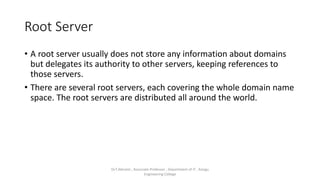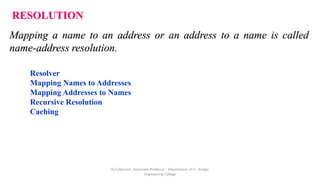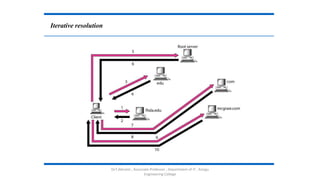Application layer : DNS
- 1. Application Layer Dr.T.Abirami , Associate Professor , Department of IT , Kongu Engineering College
- 2. Application Layer • The application layer provides services to the user. • Communication is provided using a logical connection, which means that the two application layers assume that there is an imaginary direct connection through which they can send and receive messages. • The application layer in the OSI model is the closest layer to the end user which means that the application layer and end user can interact directly with the software application. The application layer programs are based on client and servers. Dr.T.Abirami , Associate Professor , Department of IT , Kongu Engineering College
- 3. Services of Application Layers • Network Virtual terminal: An application layer allows a user to log on to a remote host. • File Transfer, Access, and Management (FTAM): An application allows a user to access files in a remote computer, to retrieve files from a computer and to manage files in a remote computer. • Addressing: To obtain communication between client and server, there is a need for addressing. DNS is used. • Mail Services: An application layer provides Email forwarding and storage. • Directory Services: An application contains a distributed database that provides access for global information about various objects and services. • Authentication: It authenticates the sender or receiver's message or both. Dr.T.Abirami , Associate Professor , Department of IT , Kongu Engineering College
- 4. Domain Name System(DNS) • It is a directory service that provides a mapping between the name of a host on the network and its numerical address. • DNS is required for the functioning of the internet. • Each node in a tree has a domain name, and a full domain name is a sequence of symbols specified by dots. • DNS is a service that translates the domain name into IP addresses. This allows the users of networks to utilize user-friendly names when looking for other hosts instead of remembering the IP addresses. • For example, suppose the FTP site at EduSoft had an IP address of 132.147.165.50, most people would reach this site by specifying ftp.EduSoft.com. Therefore, the domain name is more reliable than IP address. Dr.T.Abirami , Associate Professor , Department of IT , Kongu Engineering College
- 5. Example of using the DNS service the binding between the names and IP addresses. Dr.T.Abirami , Associate Professor , Department of IT , Kongu Engineering College
- 6. Dr.T.Abirami , Associate Professor , Department of IT , Kongu Engineering College
- 7. Name Space • A name space that maps each address to a unique name • A name in this space is a sequence of characters without structure • It can be organized in two ways: flat name space or hierarchical name space . • Flat : a name is assigned to an address. A name in this space is a Sequence of characters without structure. • hierarchical name space : each name is made of several parts. 1. The first part can define the nature of the organization 2. the second part can define the name of an organization 3. the third part can define departments in the organization Dr.T.Abirami , Associate Professor , Department of IT , Kongu Engineering College
- 8. Domain Name Space • DNS is broken up into domains, a logical organization of computers that exist in a larger network. • To have a hierarchical name space, a domain name space was designed. • In this design the names are defined in an inverted-tree structure with the root at the top. The tree can have only 128 levels: level 0 (root) to level 127. • The domain name space is divided into three different sections: generic domains, country domains, and inverse domain. Dr.T.Abirami , Associate Professor , Department of IT , Kongu Engineering College
- 9. Domain name space Each node in the tree has a label, which is a string with a maximum of 63 characters. The root label is a null string (empty string). Dr.T.Abirami , Associate Professor , Department of IT , Kongu Engineering College
- 10. Label • Each node in the tree has a label, which is a string with a maximum of 63 characters. • The root label is a null string (empty string). DNS requires that children of a node • (nodes that branch from the same node) have different labels, which guarantees the uniqueness of the domain names. Dr.T.Abirami , Associate Professor , Department of IT , Kongu Engineering College
- 11. Domain Name • Each node in the tree has a domain name. • A full domain name is a sequence of labels separated by dots (.). • The domain names are always read from the node up to the root. • The last label is the label of the root (null). • If a label is terminated by a null string, it is called a fully qualified domain name (FQDN). The name must end with a null label, but because null means nothing, the label ends with a dot. • If a label is not terminated by a null string, it is called a partially qualified domain name (PQDN). • A PQDN starts from a node, but it does not reach the root. It is used when the name to be resolved belongs to the same site as the client. • Here the resolver can supply the missing part, called the suffix, to create an FQDN. Dr.T.Abirami , Associate Professor , Department of IT , Kongu Engineering College
- 12. Dr.T.Abirami , Associate Professor , Department of IT , Kongu Engineering College
- 13. Dr.T.Abirami , Associate Professor , Department of IT , Kongu Engineering College
- 14. DISTRIBUTION OF NAME SPACE The information contained in the domain name space must be stored. However, it is very inefficient and also unreliable to have just one computer store such a huge amount of information. Hierarchy of Name Servers Zone Root Server Primary and Secondary Servers Topics discussed in this section: Dr.T.Abirami , Associate Professor , Department of IT , Kongu Engineering College
- 15. Figure 25.6 Hierarchy of name servers Dr.T.Abirami , Associate Professor , Department of IT , Kongu Engineering College
- 16. hierarchical name space • In hierarchical name space, each name consists of several parts. • First part defines the nature of the organization, second part defines the name of an organization, third part defines department of the organization, and so on. • In hierarchical name space, the authority to assign and control the name spaces can be decentralized. • Authority for names in each partition is passed to each designated agent. Dr.T.Abirami , Associate Professor , Department of IT , Kongu Engineering College
- 17. Zone • the complete domain name hierarchy cannot be stored on a single server, it is divided among many servers. What a server is responsible for or has authority over is called a zone. Dr.T.Abirami , Associate Professor , Department of IT , Kongu Engineering College
- 18. Root Server • A root server usually does not store any information about domains but delegates its authority to other servers, keeping references to those servers. • There are several root servers, each covering the whole domain name space. The root servers are distributed all around the world. Dr.T.Abirami , Associate Professor , Department of IT , Kongu Engineering College
- 19. DNS defines two types of servers 1. primary server and 2. Secondary server. A primary server is a server that stores a file about the zone for which it is an authority. It is responsible for creating, maintaining, and updating the zone file. It stores the zone file on a local disk. A secondary server is a server that transfers the complete information about a zone from another server (primary or secondary) and stores the file on its local disk. The secondary server neither creates nor updates the zone files. If updating is required, it must be done by the primary server, which sends the updated version to the secondary. Dr.T.Abirami , Associate Professor , Department of IT , Kongu Engineering College
- 20. DNS IN THE INTERNET • DNS is a protocol that can be used in different platforms. • In the Internet, the domain name space (tree) is divided into three different sections: generic domains, country domains, and the inverse domain. Generic Domains Country Domains Inverse Domain Dr.T.Abirami , Associate Professor , Department of IT , Kongu Engineering College
- 21. Generic Domains • It defines the registered hosts according to their generic behavior. • Each node in a tree defines the domain name, which is an index to the DNS database. • It uses three-character labels, and these labels describe the organization type. Label Description aero Airlines and aerospace companies biz Businesses or firms com Commercial Organizations coop Cooperative business Organizations edu Educational institutions gov Government institutions info Information service providers int International Organizations mil Military groups museum Museum & other nonprofit organizations name Personal names net Network Support centers org Nonprofit Organizations pro Professional individual Organizations Dr.T.Abirami , Associate Professor , Department of IT , Kongu Engineering College
- 22. Country Domain • The format of country domain is same as a generic domain, but it uses two- character country abbreviations (e.g., us for the United States) in place of three character organizational abbreviations. Dr.T.Abirami , Associate Professor , Department of IT , Kongu Engineering College
- 23. Inverse Domain • The inverse domain is used for mapping an address to a name. When the server has received a request from the client, and the server contains the files of only authorized clients. • To determine whether the client is on the authorized list or not, it sends a query to the DNS server and ask for mapping an address to the name. Dr.T.Abirami , Associate Professor , Department of IT , Kongu Engineering College
- 24. Dr.T.Abirami , Associate Professor , Department of IT , Kongu Engineering College
- 25. RESOLUTION Mapping a name to an address or an address to a name is called name-address resolution. Resolver Mapping Names to Addresses Mapping Addresses to Names Recursive Resolution Caching Dr.T.Abirami , Associate Professor , Department of IT , Kongu Engineering College
- 26. Resolution • A host that needs to map an address to a name or a name to an address calls a DNS client called a resolver • Recursive Resolution Dr.T.Abirami , Associate Professor , Department of IT , Kongu Engineering College
- 27. Recursive resolution Dr.T.Abirami , Associate Professor , Department of IT , Kongu Engineering College
- 28. Iterative Resolution • In iterative resolution, each server that does not know the mapping sends the IP address of the next server back to the one that requested it. Dr.T.Abirami , Associate Professor , Department of IT , Kongu Engineering College
- 29. Iterative resolution Dr.T.Abirami , Associate Professor , Department of IT , Kongu Engineering College
- 30. Caching • Each time a server receives a query for a name that is not in its domain, it needs to search its database for a server IP address. • Reduction of this search time would increase efficiency. DNS handles this with a mechanism called caching. • First, the authoritative server always adds information to the mapping called time to live (TTL). It defines the time in seconds that the receiving server can cache the information. • Second, DNS requires that each server keep a TTL counter for each mapping it caches. Dr.T.Abirami , Associate Professor , Department of IT , Kongu Engineering College
- 31. Resource Records • The zone information associated with a server is implemented as a set of resource records. • In other words, a name server stores a database of resource records. • A resource record is a 5-tuple structure (Domain Name, Type, Class, TTL, Value) • The domain name field is what identifies the resource record. • The value defines the information kept about the domain name. • The TTL defines the number of Iterative resolution seconds for which the information is valid. Dr.T.Abirami , Associate Professor , Department of IT , Kongu Engineering College






























